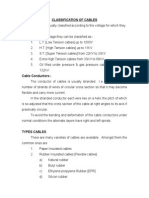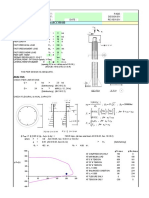0 ratings0% found this document useful (0 votes)
5 ElectMatrlsEqpmnt - 3
5 ElectMatrlsEqpmnt - 3
Uploaded by
Natalie CorpuzThis document discusses different types of building wires and their applications. It covers thermoplastic cables made of copper with PVC or nylon insulation, and identifies common wire types by their codes like THHN and THWN. It also discusses determining conductor ampacity based on wire thickness, material and insulation. Additional topics include electrical enclosures, different types of conduits and raceways, and common applications of electric motors in homes.
Copyright:
© All Rights Reserved
Available Formats
Download as PDF, TXT or read online from Scribd
Download as pdf or txt
5 ElectMatrlsEqpmnt - 3
5 ElectMatrlsEqpmnt - 3
Uploaded by
Natalie Corpuz0 ratings0% found this document useful (0 votes)
This document discusses different types of building wires and their applications. It covers thermoplastic cables made of copper with PVC or nylon insulation, and identifies common wire types by their codes like THHN and THWN. It also discusses determining conductor ampacity based on wire thickness, material and insulation. Additional topics include electrical enclosures, different types of conduits and raceways, and common applications of electric motors in homes.
Original Title
5 ElectMatrlsEqpmnt_3
Copyright
© © All Rights Reserved
Available Formats
PDF, TXT or read online from Scribd
Share this document
Did you find this document useful?
Is this content inappropriate?
This document discusses different types of building wires and their applications. It covers thermoplastic cables made of copper with PVC or nylon insulation, and identifies common wire types by their codes like THHN and THWN. It also discusses determining conductor ampacity based on wire thickness, material and insulation. Additional topics include electrical enclosures, different types of conduits and raceways, and common applications of electric motors in homes.
Copyright:
© All Rights Reserved
Available Formats
Download as PDF, TXT or read online from Scribd
Download as pdf or txt
0 ratings0% found this document useful (0 votes)
5 ElectMatrlsEqpmnt - 3
5 ElectMatrlsEqpmnt - 3
Uploaded by
Natalie CorpuzThis document discusses different types of building wires and their applications. It covers thermoplastic cables made of copper with PVC or nylon insulation, and identifies common wire types by their codes like THHN and THWN. It also discusses determining conductor ampacity based on wire thickness, material and insulation. Additional topics include electrical enclosures, different types of conduits and raceways, and common applications of electric motors in homes.
Copyright:
© All Rights Reserved
Available Formats
Download as PDF, TXT or read online from Scribd
Download as pdf or txt
You are on page 1/ 17
Building Electrical
Materials and Equipment
(Building Wires and
Ampacity)
Building Wires
Thermoplastic Cables. Single insulated conductor of solid or stranded bare annealed high
conductivity copper, with thermoplastic lead free insulation of PVC (Polyvinyl Chloride) and
protected by a nylon jacket; normally designed to operate up to 600 V.
Conductor Application and Insulations
Wire Coding and Identification
Codes printed on the thermoplastic insulation.
Identify the wire as suitable for use in conduit:
(a) THHN; (b) THWN
THHN wire is thermoplastic high heat-resistant nylon coated
wire.
THWN is thermoplastic heat- and water-resistant nylon
coated wire.
THW Thermoplastic Heat and Water Resistant
"T" stands for thermoplastic insulation covering the wire itself.
"H" stands for a heat resistance of the insulation max 167°F.
"HH" stands for a heat resistance, but increased max 194°F.
"W" is for moisture resistant.
"N" is for a nylon coating make the insulation oil and gas
resistant.
Conductor Ampacity
• Conductor’s Ampacity – it is the maximum current it can carry continuously
without exceeding the temperature limitations of the insulation and sheathing
material.
• Ampacity is based on the following:
a. Wire thickness
b. Type of conductor material
c. Insulation and sheathing type
d. Number of conductors bundled in the sheathing
e. Temperature and exposure of the conductor
Ampacity
Table
based on
the PEC
Enclosures and Raceways
• Enclosures – are electrical boxes and cabinets made of metal (e.g., steel,
galvanized steel, aluminum, and so on) or nonmetallic (plastic) materials that
provide protection for conductors, connections, controls, and other electrical
equipment.
• Electrical boxes – are metal and non-metallic (plastic) enclosures that hold devices
such as switches or outlets and safely permit wiring connections. Boxes are
available in four primary shapes: square, rectangular, octagonal, or round.
• Junction boxes (J-boxes) – are a special type of electrical box used to enclose
conductor connections. Connections are commonly called junctions in the trade.
• Pull box – is a type of junction box that allows access to a raceway for snaking
conductors through the raceway. Knockouts in most boxes and other enclosures
can be easily removed to allow wiring to enter the box.
Conduit and Other Raceways
• Raceway – is an enclosed channel such as a conduit, tube,
or gutter designed for holding wires, cables, or busbars.
• Types of Conduits:
a. Rigid metal conduit
b. Intermediate metal conduit (IMC)
c. Electrical metallic tubing (EMT)
d. Electrical nonmetallic tubing (ENT)
e. Rigid nonmetallic conduit
f. Flexible metal conduit
g. Liquid tight flexible metal conduit
h. Liquid tight flexible nonmetallic conduit
i. Cellular concrete floor raceways
Conduit
Sizes
based on
the PEC
Busways and Wireways
• Busway – is of a standardized, factory-assembled enclosure consists of outer
duct-like housing, bus bars, and insulators.
• Wire gutters or wireways – are sheet metal or nonmetallic, flame-resistant plastic
troughs that serve as a housing that encloses and protects conductors.
Electric Motors
In homes, electric motors are found in refrigerators,
freezers, dishwashers, kitchen sink waste disposal,
portable kitchen appliances, exhaust and ventilation
fans, clothes washers and dryers, furnaces, air
conditioners, and paddle fans.
Motor
Ratings
based
on the
PEC
THANK
YOU.
You might also like
- BXUV.P213 - Fire-Resistance Ratings - ANSI - UL 263 - UL Product IqNo ratings yetBXUV.P213 - Fire-Resistance Ratings - ANSI - UL 263 - UL Product Iq4 pages
- Electric Boiler Design Calculations-ASME SEC.I, PART-PEB, EDITION 2019 PDFNo ratings yetElectric Boiler Design Calculations-ASME SEC.I, PART-PEB, EDITION 2019 PDF48 pages
- 1 Basic Components in Electrical System Design (Part 1)No ratings yet1 Basic Components in Electrical System Design (Part 1)39 pages
- Electrical Installation and Maintenance (Eim)No ratings yetElectrical Installation and Maintenance (Eim)43 pages
- Enclosures and Raceways: By: John Paul C. MalalaNo ratings yetEnclosures and Raceways: By: John Paul C. Malala31 pages
- Electrical Conduits & Fittings: Protect Electrical Cables and WiresNo ratings yetElectrical Conduits & Fittings: Protect Electrical Cables and Wires18 pages
- Cables and Cable Glands Questions and Answers100% (1)Cables and Cable Glands Questions and Answers46 pages
- Chapter 2, Standards, Electrical MaterialsNo ratings yetChapter 2, Standards, Electrical Materials46 pages
- Chapter 2,3standards, Electrical MaterialsNo ratings yetChapter 2,3standards, Electrical Materials92 pages
- Different Types of Electrical Wires and CablesNo ratings yetDifferent Types of Electrical Wires and Cables8 pages
- Electrical Installation Handout (ch1 - ch4)No ratings yetElectrical Installation Handout (ch1 - ch4)32 pages
- 8d d38999 Mil-Dtl-38999 Series III PDF CatalogueNo ratings yet8d d38999 Mil-Dtl-38999 Series III PDF Catalogue152 pages
- List of Materials Used in CK Actuators.: Title: Materials Used On CK Range Models: CK, Cka, CKR, Ckra, CKC, CKRCNo ratings yetList of Materials Used in CK Actuators.: Title: Materials Used On CK Range Models: CK, Cka, CKR, Ckra, CKC, CKRC1 page
- Concrete Pier Design Based On ACI 318-05: Input Data & Design SummaryNo ratings yetConcrete Pier Design Based On ACI 318-05: Input Data & Design Summary3 pages
- BOQ - Epoxy Paint For Villas & Club HouseNo ratings yetBOQ - Epoxy Paint For Villas & Club House9 pages
- 301-00-CL-SPC-00013 - NFXP3 Common Plant Drainage & Sewer System Specs.No ratings yet301-00-CL-SPC-00013 - NFXP3 Common Plant Drainage & Sewer System Specs.44 pages
- LECTURE 3 - Plumbing Materials and FittingsNo ratings yetLECTURE 3 - Plumbing Materials and Fittings14 pages
- Grade Comparison Chart of Indian ProducersNo ratings yetGrade Comparison Chart of Indian Producers2 pages
- 9" 2-16tor ST Stirrups 12" 2-16tor ST PB-1:9"X12": Produced by An Autodesk Student VersionNo ratings yet9" 2-16tor ST Stirrups 12" 2-16tor ST PB-1:9"X12": Produced by An Autodesk Student Version1 page
- HSS - American Institute of Steel ConstructionNo ratings yetHSS - American Institute of Steel Construction4 pages
- Materials Today: Proceedings: K. Naveen Kumar, D.S. Vijayan, R. Divahar, R. Abirami, C. NivethaNo ratings yetMaterials Today: Proceedings: K. Naveen Kumar, D.S. Vijayan, R. Divahar, R. Abirami, C. Nivetha5 pages
- BXUV.P213 - Fire-Resistance Ratings - ANSI - UL 263 - UL Product IqBXUV.P213 - Fire-Resistance Ratings - ANSI - UL 263 - UL Product Iq
- Electric Boiler Design Calculations-ASME SEC.I, PART-PEB, EDITION 2019 PDFElectric Boiler Design Calculations-ASME SEC.I, PART-PEB, EDITION 2019 PDF
- 1 Basic Components in Electrical System Design (Part 1)1 Basic Components in Electrical System Design (Part 1)
- Electrical Conduits & Fittings: Protect Electrical Cables and WiresElectrical Conduits & Fittings: Protect Electrical Cables and Wires
- List of Materials Used in CK Actuators.: Title: Materials Used On CK Range Models: CK, Cka, CKR, Ckra, CKC, CKRCList of Materials Used in CK Actuators.: Title: Materials Used On CK Range Models: CK, Cka, CKR, Ckra, CKC, CKRC
- Concrete Pier Design Based On ACI 318-05: Input Data & Design SummaryConcrete Pier Design Based On ACI 318-05: Input Data & Design Summary
- 301-00-CL-SPC-00013 - NFXP3 Common Plant Drainage & Sewer System Specs.301-00-CL-SPC-00013 - NFXP3 Common Plant Drainage & Sewer System Specs.
- 9" 2-16tor ST Stirrups 12" 2-16tor ST PB-1:9"X12": Produced by An Autodesk Student Version9" 2-16tor ST Stirrups 12" 2-16tor ST PB-1:9"X12": Produced by An Autodesk Student Version
- Materials Today: Proceedings: K. Naveen Kumar, D.S. Vijayan, R. Divahar, R. Abirami, C. NivethaMaterials Today: Proceedings: K. Naveen Kumar, D.S. Vijayan, R. Divahar, R. Abirami, C. Nivetha

























































































